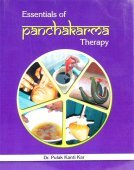Snehana: 11 definitions
Introduction:
Snehana means something in Hinduism, Sanskrit, Marathi. If you want to know the exact meaning, history, etymology or English translation of this term then check out the descriptions on this page. Add your comment or reference to a book if you want to contribute to this summary article.
In Hinduism
Ayurveda (science of life)
Rasashastra (Alchemy and Herbo-Mineral preparations)
Source: Indian National Science Academy: Annual Report 2015-16 (rasashastra)Snehana (स्नेहन, “oleation”) refers to one of the five Pañcakarma for Rasaśāstra as introduced (as a new set) in the Āyurvedaprakāśa: an exclusive text on Rasaśāstra the pharmaceutical wing of Ayurveda that concentrates on preparation of herbo-mineral medicaments, written in 17th Century AD by Mādhava Upādhyaya.
Unclassified Ayurveda definitions
Source: Wisdom Library: Āyurveda and botanySnehana (स्नेहन, “lubrication”).—One of the six Upakramas, or ‘therapeutic measures’.—It is a Sanskrit technical term used through Ayurvedic (Indian medicine) literature such as the Carakasaṃhitā. The six Upakramas represent basic Ayurvedic therapies. The Snehana treatment refers to a “oiling/oleating therapy” and aims to fight diseases of all doṣas, by applying oily substances, though it favors the reduction of Vāta in particular.

Āyurveda (आयुर्वेद, ayurveda) is a branch of Indian science dealing with medicine, herbalism, taxology, anatomy, surgery, alchemy and related topics. Traditional practice of Āyurveda in ancient India dates back to at least the first millenium BC. Literature is commonly written in Sanskrit using various poetic metres.
General definition (in Hinduism)
Source: Wisdom Library: Hinduism1) Snehana (oleation therapy) is a clinical feature used in Ayurveda.
2) Snehana can also mean 'anointing' (one of the paṅcakarmas)
Languages of India and abroad
Marathi-English dictionary
Source: DDSA: The Molesworth Marathi and English Dictionarysnēhana (स्नेहन).—n S Rubbing with unguents, anointing. 2 In medicine. Application or exhibition of oil or oleaginous substances.
Marathi is an Indo-European language having over 70 million native speakers people in (predominantly) Maharashtra India. Marathi, like many other Indo-Aryan languages, evolved from early forms of Prakrit, which itself is a subset of Sanskrit, one of the most ancient languages of the world.
Sanskrit dictionary
Source: DDSA: The practical Sanskrit-English dictionarySnehana (स्नेहन).—a. [snih-ṇic lyu lyuṭ vā]
1) Anointing, lubricating.
2) Destroying.
-nam 1 Anointing, unction, rubbing or smearing with oil or unguents.
2) Unctuousness.
3) An unguent, emollient.
Source: Cologne Digital Sanskrit Dictionaries: Shabda-Sagara Sanskrit-English DictionarySnehana (स्नेहन).—n.
(-naṃ) 1. Unctuousness, being or becoming oily, &c. 2. Anointing, unction, rubbing with unguents, oil, &c. 3. An emollient, an unguent or liniment. f.
(-nā) Adj. 1. Anointing, lubricating. 2. Destroying. m.
(-naḥ) Siva. E. ṣṇih to be unctuous, lyuṭ aff.
Source: Cologne Digital Sanskrit Dictionaries: Benfey Sanskrit-English DictionarySnehana (स्नेहन).—i. e. snih + ana, n. 1. Anointing. 2. Unctuousness. 3. An unguent, an emollient.
Source: Cologne Digital Sanskrit Dictionaries: Cappeller Sanskrit-English DictionarySnehana (स्नेहन).—[adjective] ([feminine] ī) & [neuter] lubricating, anointing; feeling affection.
Source: Cologne Digital Sanskrit Dictionaries: Monier-Williams Sanskrit-English Dictionary1) Snehana (स्नेहन):—[from snih] mf(ī)n. anointing, lubricating, [Suśruta; Bhāvaprakāśa]
2) [v.s. ...] m. ‘feeling affection’, Name of Śiva (cf. a-sn), [Mahābhārata]
3) [v.s. ...] n. unction, lubrication, rubbing or smearing with oil or unguents, [Caraka]
4) [v.s. ...] unctuousness, being or becoming oily, [Dhātupāṭha]
5) [v.s. ...] feeling affection, [Sāyaṇa]
Source: Cologne Digital Sanskrit Dictionaries: Yates Sanskrit-English DictionarySnehana (स्नेहन):—(naṃ) 1. n. Unctuousness; anointing; a liniment.
[Sanskrit to German]
Sanskrit, also spelled संस्कृतम् (saṃskṛtam), is an ancient language of India commonly seen as the grandmother of the Indo-European language family (even English!). Closely allied with Prakrit and Pali, Sanskrit is more exhaustive in both grammar and terms and has the most extensive collection of literature in the world, greatly surpassing its sister-languages Greek and Latin.
See also (Relevant definitions)
Ends with: Asnehana, Sadyahsnehana, Samsnehana, Utsnehana.
Full-text: Sadyahsnehana, Utsnehana, Samsnehana, Asnehana, Medadhatu, Upakrama, Putapaka, Pancakarma, Griva Vasti, Anuvasana, Plush, Sneha.
Relevant text
Search found 7 books and stories containing Snehana, Snēhana; (plurals include: Snehanas, Snēhanas). You can also click to the full overview containing English textual excerpts. Below are direct links for the most relevant articles:
Sushruta Samhita, Volume 6: Uttara-tantra (by Kaviraj Kunja Lal Bhishagratna)
Chapter XVIII - Preparations and medicinal measures for ocular affections in general < [Canto I - Shalakya-tantra (ears, eyes, nose, mouth and throat)]
Chapter IX - Treatment of Vataja Ophthalmia < [Canto I - Shalakya-tantra (ears, eyes, nose, mouth and throat)]
Chapter XXVI - Treatment of diseases of the head < [Canto I - Shalakya-tantra (ears, eyes, nose, mouth and throat)]
Sushruta Samhita, volume 4: Cikitsasthana (by Kaviraj Kunja Lal Bhishagratna)
Chapter XXXI - The medicinal use of Sneha (oleaginous substances)
Chapter XL - Description of medicated fumes, snuffs, errhines and gargles
Chapter XXXV - Description of a Netra and a Vasti (pipes, nozzles and apparatus)
Atharvaveda and Charaka Samhita (by Laxmi Maji)
Kāśyapa Saṃhitā (Āyurveda book) < [Chapter 1 - Introduction]
Bhela and Bhela Saṃhitā < [Chapter 1 - Introduction]
Cosmetics, Costumes and Ornaments in Ancient India (by Remadevi. O.)
2.2. Pharmaceutical use of Añjana (Collyrium) < [Chapter 1 - Cosmetics]
Charaka Samhita and Sushruta Samhita (by Nayana Sharma)
Precautionary measures for good health and Prophylactic Measures < [Chapter 6]
Knowledge of Dietetics < [Chapter 7]
Class and Gender (Introduction) < [Chapter 5]
History of Indian Medicine (and Ayurveda) (by Shree Gulabkunverba Ayurvedic Society)
Chapter 14 - The Individual and Medicine < [Part 2-3 - Medical Institutions in Ancient India]
Chapter 9a - Vitiation Process (dosha-prakopa) < [Part 6 - The Science of the Triumvirate (Tridosha) Pathogenesis]
Related products

